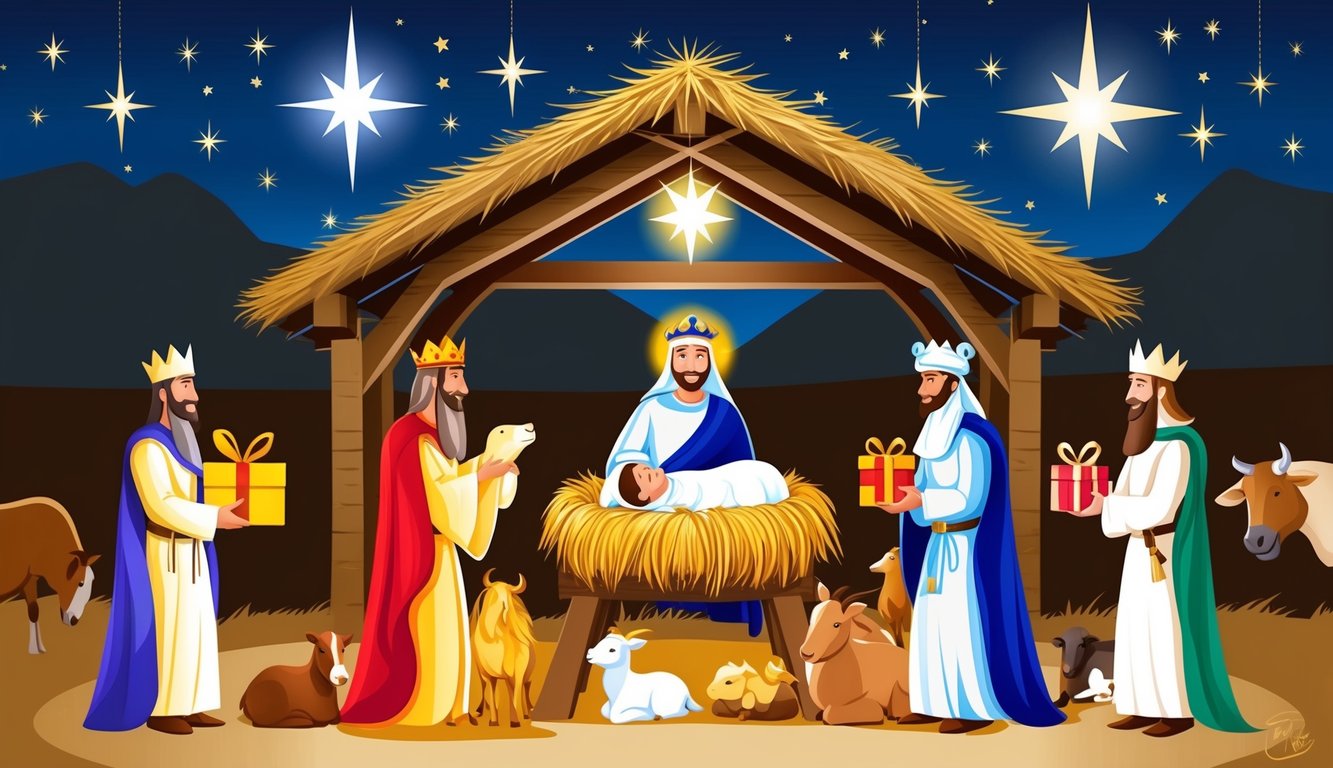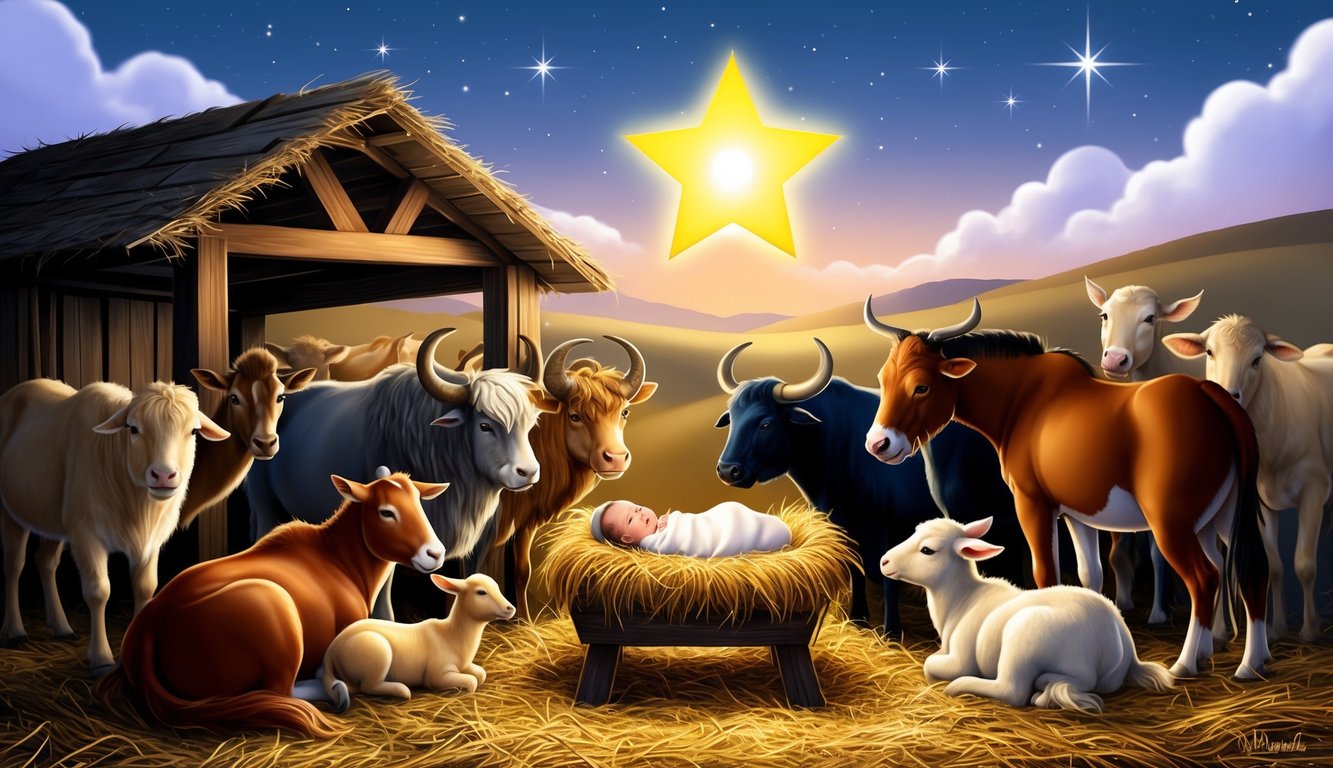Don’t Miss Out On This Unique Astrological Opportunity
Are you tired of spinning your wheels and getting nowhere? Simply put, you’re out of sync: you’re out of alignment with your astral configuration.
But: there’s a kind of map that can help you reclaim your alignment. Think of it as your own personal blueprint to success and happiness: a blueprint that will help you live your most amazing life.
Get started here.
Have you ever wondered about the birth of Jesus and its significance in Christianity? The Gospels in the New Testament speak of this significant event, marking the arrival of the Messiah in Bethlehem.
Many have traditionally celebrated Jesus’s birth on December 25.
This date, though symbolic, highlights the importance and divine mystery surrounding this event.
As you explore the story of the birth of Jesus, you’ll find it filled with rich narratives and characters.
According to the Gospel of Luke, an angel announced Jesus’s arrival to the shepherds, a sign of hope and joy for mankind.
The Gospels weave a tale that emphasizes Jesus’s humble beginnings and his destined role as the savior.
The question of where and when Jesus was born has intrigued believers and scholars alike.
Most agree he was born in Bethlehem.
Each Gospel offers unique insights that deepen the understanding of Jesus’s birth and its significance in Christian faith.
With such a profound story, there’s much to reflect on and celebrate.
The Historical Context of Jesus’ Birth
When you look at the birth of Jesus, it’s important to see it within the broader historical and social landscape.
This involves the Roman Empire’s influence, the choice of Bethlehem as a birthplace, and Jesus’ connection to King David’s lineage.

Roman Rule and the Census
At the time of Jesus’ birth, the Roman Empire ruled over Judea, a province where Jews lived under Roman governance.
One key event was the census ordered by Caesar Augustus.
This required everyone, including Joseph and Mary, to return to their ancestral towns to be counted.
Joseph, being from the house of David, had to travel to Bethlehem.
This decree shows the extensive reach of Roman authority in Galilee and Judea.
The census not only emphasized the empire’s control but also set the stage for Mary and Joseph’s journey, leading them from Nazareth to Bethlehem, where Jesus would be born.
Prophetic Significance of Bethlehem
Bethlehem holds significant value due to its Prophetic importance.
It was foretold in Jewish prophecy that the Messiah would come from this town.
Known as the City of David, Bethlehem links Jesus to Jewish expectations of a savior, as prophesied in the Old Testament book of Micah.
This small town, rich in history, provided the prophetic credentials needed for messianic claims.
Jesus’ birth in Bethlehem fulfilled these ancient prophecies, making it a central part of Christian teachings.
The connection between the place and the prophetic words highlights the importance of Bethlehem as the starting point of what Christians believe to be a divine mission.
The Lineage of King David
Tracing Jesus’ ancestry to King David was crucial for establishing his role as the expected Messiah, often called the “King of the Jews.” This lineage is presented in the biblical accounts in both the gospels of Matthew and Luke.
Joseph, Jesus’ legal father, descended from David’s line, anchoring Jesus in Jewish royal heritage.
This royal lineage confirmed expectations of a messiah from David’s house, reinforcing Jesus’ legitimacy in the eyes of his earliest followers.
This deep connection to David not only fulfilled Jewish prophecies but also bolstered the claims of Jesus’ significance within Jewish tradition and Christian teachings.
The Nativity Story According to the Gospels
The birth of Jesus is a significant event described in the Gospels.
The Gospel of Matthew focuses on the visit of the Magi, while the Gospel of Luke highlights the shepherds and angels celebrating the birth.
Each Gospel provides unique details that enrich the story of the Nativity.
Gospel of Matthew: The Visit of the Magi
In the Gospel of Matthew, you read about the Magi, or wise men, who travel from the East to honor the newborn Jesus.
These respected figures follow a star to find the child, who is recognized as the future king of the Jews.
When they reach Bethlehem, the Magi meet Mary and Joseph and present three gifts: gold, frankincense, and myrrh.
These gifts carry deep meaning, reflecting Jesus’ royalty, divinity, and future suffering.
Matthew’s narrative is compelling because it involves Herod the Great.
Upon learning of Jesus’ birth, Herod becomes troubled and deceitfully sends the Magi to find Jesus, intending to harm him.
However, the Magi are warned in a dream not to return to Herod, showcasing how divine intervention plays a key role in protecting Jesus.
This theme of divine protection and fulfillment of prophecy is central to Matthew’s Gospel, reinforcing Jesus’ identity as the Messiah.
Later in the narrative, the contrast between Herod’s deception and God’s guidance parallels the events of Matthew 27 and the Passion, where human schemes are ultimately overcome by divine will.
Through these connections, Matthew emphasizes God’s sovereignty over history and the fulfillment of His redemptive plan.
Gospel of Luke: The Shepherds and Angels
The Gospel of Luke offers a different perspective, spotlighting humble shepherds watching over their flocks at night.
Suddenly, an angel appears to them, announcing the joyous news of Jesus’ birth in Bethlehem.
You see how the angel tells them that the child, wrapped in cloths and lying in a manger, will be a savior for all people.
After the announcement, a multitude of angels join, praising God and bringing light to the night sky.
This celestial event emphasizes the importance of Jesus’ birth and brings the shepherds great joy.
They quickly head to Bethlehem to witness the miracle themselves and share the extraordinary news with everyone they meet.
Important Figures in the Story of Jesus’ Birth

In the story of Jesus’ birth, several significant figures played crucial roles.
These include Joseph and Mary, who were central to Jesus’ early life, and Herod the Great, whose actions were driven by fear.
Additionally, the angel Gabriel had a vital role in delivering divine messages.
Each figure contributes uniquely to this historical and religious narrative.
Joseph: The Earthly Father of Jesus
Joseph played a protective and guiding role in Jesus’ early years.
As a carpenter, he provided for the family and ensured their safety during challenging times.
According to the Bible, Joseph was engaged to Mary when he discovered her pregnancy.
He initially considered divorcing her quietly, not wanting to expose her to public disgrace.
However, after receiving guidance from an angel in a dream, he accepted his role as Jesus’ earthly father.
His decision to take Mary and Jesus to Egypt to escape King Herod’s wrath, as described in the Gospel of Matthew, highlights his dedication and courage.
Joseph’s actions fulfill the prophecies and demonstrate his commitment to his family.
Mary: The Virgin Mother
Mary is celebrated as the mother of Jesus and is revered for her faith and purity.
As a young woman in Nazareth, she was visited by the angel Gabriel, who announced that she would conceive a child by the Holy Spirit.
Despite her initial confusion, Mary accepted this divine message with faith and humility, understanding her role in God’s plan.
Mary’s journey to Bethlehem with Joseph, while pregnant, reflects her strength and resilience.
Her experiences, including giving birth to Jesus in humble surroundings, highlight her devotion and trust in God’s will.
Mary’s significance extends beyond motherhood, as she is seen as a symbol of grace and compassion in Christianity.
Herod the Great: The King’s Fear
Herod the Great was the king of Judea during the time of Jesus’ birth.
Known for his building projects, he also feared losing his throne.
This fear drove Herod to take extreme measures, including ordering the massacre of all boys in Bethlehem under the age of two, known historically as the Massacre of the Innocents.
His actions were fueled by the prophecy of a new king of the Jews, which he saw as a direct threat to his rule.
Influenced by the Magi’s visit and their search for the newborn Messiah, Herod’s paranoia illustrates the political tension during Jesus’ birth.
This event forced Joseph and Mary to flee to Egypt, keeping Jesus safe from harm.
The Role of Angel Gabriel
Angel Gabriel is a central figure in the annunciation of Jesus’ birth.
As a messenger of God, Gabriel appeared to Mary, delivering the news that she would give birth to the Messiah.
Despite Mary’s initial fear, Gabriel provided reassurance and detailed how this miraculous event would occur, emphasizing that nothing is impossible with God.
Gabriel’s role extends beyond delivering news to Mary.
He also appeared to Joseph in a dream, urging him to marry Mary and protect Jesus.
Gabriel’s messages connected the earthly events with divine intervention, emphasizing God’s plan for humanity through Jesus’ birth.
Gabriel’s presence assured both Mary and Joseph of their roles in this profound story.
The Symbolism and Traditions of Christmas

Christmas is rich with symbolism and traditions rooted in the Bible and Christian faith.
You may be familiar with the gifts of the Wise Men and the guiding Star of Bethlehem, which remain central to many holiday celebrations.
Gift Giving: Gold, Frankincense, and Myrrh
Gold, frankincense, and myrrh are the famous gifts given to Jesus by the Wise Men.
Each gift had special meaning. Gold represented Jesus’ kingship.
It was a precious metal, showcasing wealth and status. Frankincense was used in worship, symbolizing Jesus’ deity.
This fragrant resin was burned during religious ceremonies, creating a sense of reverence.
Myrrh had a more somber symbolism.
It was often used for burial practices, hinting at Jesus’ future suffering and death.
This connection adds depth to the Christmas story.
Today, these gifts inspire modern Christmas gift-giving, reminding you of the spiritual significance behind the tradition.
The Star of Bethlehem and Wise Men
The Star of Bethlehem is a key symbol in the Nativity story.
According to the Bible, this bright star led the Wise Men, or Magi, to the birthplace of Jesus.
These Wise Men were likely scholars or astrologers.
They followed the star across long distances, convinced of its important message.
The star represented hope and guidance.
For many, it symbolizes divine intervention.
This story continues to inspire Christmas decorations, where you might see stars topping trees or shining as lights.
Christmas Date and Cultural Celebrations
Christmas is celebrated on December 25.
This date holds significant meaning, although it is not believed to be Christ’s actual birthdate.
The choice coincided with the Winter Solstice and the Roman festival of Saturnalia, a time of feasting and joy in the Julian Calendar era.
Over time, Christmas incorporated many cultural customs.
In different parts of the world, you can experience unique ways of celebrating.
Some traditions include feasts, caroling, and festive decorations.
These customs invite you to reflect on the joy and spirit of the season, honoring Christ’s birth in a variety of heartfelt ways.
Scholarly Perspectives on the Birth of Jesus

Exploring scholarly views on the birth of Jesus reveals intriguing questions about historical evidence, theological implications, and societal impacts through time.
Scholars analyze dates, cultural contexts, and the meaning behind these stories for early Christians.
Historical Evidence and Chronology Discrepancies
Historians have different opinions about when Jesus was born.
The Gospels say he was born during the reign of Caesar Augustus, but they don’t offer exact dates.
In the 6th century, Dionysius Exiguus tried to calculate this, which later influenced the calendar system.
Several scholars point to Tiberius’s reign to further narrow down the timeline.
Yet, discrepancies remain, as different sources suggest slightly different years.
These differing records make the exact year hard to pinpoint.
Theological Interpretations and Christology
Theology offers another lens to view the birth of Jesus.
Many scholars see it as a critical Christological moment that defines early Christian beliefs.
The Apostle Paul emphasized Jesus’s birth in shaping Christology, or the study of Christ’s nature.
His letters reflect early theological interpretations that still impact Christian thought today.
This focus on understanding divinity and humanity through his birth remains a central theme in Christian theology.
Cultural and Societal Impact through the Centuries
The story of Jesus’s birth has shaped culture and society for centuries.
The Christian Church in the 4th century began celebrating the Nativity, which later became a significant annual event around the world.
Beyond its religious importance, this tale has influenced art, literature, and music, contributing to Western cultural heritage.
Scholars note how societal norms and cultural expressions evolved in response to various interpretations of Jesus’s birth, impacting millions globally.



